Mahi-mahi may not enjoy the same status as tunas and marlin, but few things get the offshore adrenaline pumping harder than watching a school of green and blue missiles racing for your bait at warp speed. Once on the hook these fish go absolutely insane, and once in a taco they become terrifically tasty. And there’s no better way to get that visual buzz of watching them eat than to try bailing.

Here’s the rub: back in the late 90s and early 2000s I called bailing “the closest thing to a sure thing in oceanic angling.” As a general rule when you approached a lobster pot float on the edge of the shelf and tossed out a handful of chunks, 90 percent of the time you’d see those streaks of electrified color come shooting over to feast. And 90 percent of the time those fish wouldn’t hesitate to slurp down a bait or go rocketing after a plug or spoon.
We live in a different age. Back then the vast majority of the boats trolled, trolled, and trolled when they were at the canyons and it was relatively rare to see other boats focus on bailing. But there was a severe drought in the tuna bite sometime just before the Great Recession. The entire fleet might have caught a handful on any given day, and the vast majority of the boats were coming home empty-handed. The marlin bite that summer was only slightly better and again, most of the boats targeting them were skunked. More and more boats and even many of the charters—who had eschewed bailing entirely for as long as they’d been running—started pulling up to the balls.
The next summer the tuna bite wasn’t much better, and this was the same timeframe when deep-dropping for tilefish became popularized. Since then we’ve had some good years and some not so good years of offshore fishing, but no matter what the bite’s like it’s now rather difficult to fish more than two or three balls before boats have picked over all the others within range. You can bet that someone hit those very same balls within the last day or two, and on a weekend day it’s tough to get out early enough to find any that haven’t already been bailed. The net result? These days it’s common to only find fish at 25 to 50 percent of the floats you pull up to, and rather than attacking with abandon more than half the fish you see show a shocking amount of caution.

Picking Your Battles
Just how cooperative or uncooperative the fish plan to be is outside of your control, but you can tilt the odds a bit when choosing your destination. If you’re planning to bail and any one specific canyon has held a bite that’s become well known, head for a different destination. Let’s say there’s a bigeye bite at the Washington, for example. By 10 a.m. half the boats there will have bored anglers aboard who just want to catch something, and you can bet the balls will be picked over in short order. If you planned to bail all day, hopefully you headed somewhere else.
Better yet is finding balls that are strung out along the edge of the Shelf but aren’t inside one of the submarine canyons. Finding these can be dicey—they’re almost always somewhere along the canyon edges but come and go along the other contours and notches, as commercial boats move their gear around. Don’t fly blind and just hope to find some, but if you locate them while trolling or get word of a set outside of the usual areas it can be a boon. Also note that floats can sometimes be found strung next to offshore wrecks and in areas of live or rocky bottom inshore of the canyons, and these generally get a bit less pressure than those on the edge.
Best of all is spotting a thick patch of weeds, a well-defined weedline, a log, or some other form of flotsam. This will generally be a matter of luck, but when you do spot significant structure floating on the surface be quick to abandon the balls and check it out. And when weeds are spotted look for some sort of anomaly in them; if there’s a chunk of wood, a five-gallon bucket, or some other item mixed in, that’s likely where the fish will be focused.
Tempting Mahi into Biting
Okay: you’ve found some mahi, but as is often the case these days the fish have already been pounded on and someone else caught the stupid ones before you arrived. Now they’re uber-skittish and you can’t buy a bite. What’s next? There are several tactics you can use to get those nervous nellies eating. For starters, drop leader size and use a smaller hook. A fish that rejects a chunk of butterfish hanging from a 10/0 J-hook tied to 50-pound test will often slurp down that same chunk of butterfish if it’s hiding a 6/0 hook tied to 20-pound test. Just make sure it’s a circle hook and don’t give the fish too long to eat, because if a mahi’s teeth rub against that thread it’ll chafe through long before you get the fish up to the boat. Having the fish hooked through the corner of the jaw so it’s biting down on metal is the only way to win this particular battle.

Another thing you can do is offer the fish something a bit more tempting. Having live baits does the trick, so leaving the dock with a couple dozen live spot or mullet in the livewell gives you a serious advantage. The other way to get those fish biting is to toss out a whole squid and let it freefall. As the squid sinks its tentacles wiggle enticingly, and this almost always sends mahi into overdrive. The best presentation is to rig up a Squidly by clipping the tip of a squid’s mantle, running the end of your leader down through it, sliding a small egg sinker over the leader, then tying on your hook. Before going to all that effort, however, it’s worth simply threading a squid onto your hook via the tip of the mantle and tossing it over. Often that’s enough to get the job done.
Another effective tactic is to send the fish into a full-blown feeding frenzy so they start attacking anything and everything. One surefire way to do this is to throw a few handfuls of bull minnow over the side. Vigorously bounce a few off the transom to stun them so they swim in circles, and the mahi will go utterly berserk.
Battling for Mega-Mahi
Try bailing for long enough, and sooner or later you’ll see an unusually large one of 20 pounds, 30 pounds, or more. Usually these fish move alone or in pairs, and when there’s a school of chicken dolphin on a pot they’ll be off to the side and slightly away from the main body of fish. These larger specimens will often be even cagier than the others and they rarely eat a sloppily presented fish chunk.
When you spot one of these stop what you’re doing, take a breath, and focus. If you kill a bunch of chickens while they’re around the fish will eventually get the message and respond with lockjaw. Instead, prep a special rig for the big beasts. Use the heaviest appropriate rod that you have and up-size the leader to 50-pound test or more. If you have a large live bait, offer it. If not, rig on a whole ballyhoo. Those big fish want a big meal, and those chunks that are bite-sized for chicken dolphin often aren’t enough to seal the deal.
Try letting the ballyhoo freefall while giving it a wiggle here and there and sometimes they’ll inhale it. Other times they’ll swim close but won’t take it. In that case, put the boat into gear and start slow-trolling the ballyhoo in circles around the pot or flotsam.
If that doesn’t do the trick there’s one final bait-and-switch style trick you can try: rig up a rod with a four- or five-ounce bright, shiny jigging spoon, flip it out near the fish, and let it freefall for a good 100’. Then rip it back as fast as you can turn the crank. When it gets to about 20’ and you see it flashing its way up, someone else then tosses the whole ballyhoo in and lets it freefall. Though the mahi almost never hit the spoon they do often chase it and get excited. Hopefully excited enough that when they spot the ballyhoo going in the other direction they throw caution into the wind and smack it.
Times and fisheries change, and what was once as close as it gets to a sure thing offshore can leave anglers frustrated and frantic in this day and age. The gimmie is gone. But if you approach bailing with a bit more brainpower and come prepared to make an offer they can’t refuse, it’s still one of the best ways to get that offshore adrenaline pumping.